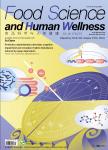Dietary lycopene mitigates nonalcoholic steatohepatitis by regulating Nrf2/PPARα-dependent ferroptosis
作者机构:College of Food Science and Nutritional Engineering, National Engineering Research Centre for Fruit and Vegetable Processing, Key Laboratory of Fruits and Vegetables Processing, Ministry of Agriculture Engineering Research Centre for Fruits and Vegetables Processing, Ministry of Education, China Agricultural University Department of Hematology and Hematopoietic Cell Transplantation Comprehensive Cancer Center, City of Hope National Medical Center
出 版 物:《Food Science and Human Wellness》 (食品科学与人类健康(英文))
年 卷 期:2024年
核心收录:
学科分类:0832[工学-食品科学与工程(可授工学、农学学位)] 1002[医学-临床医学] 08[工学] 100201[医学-内科学(含:心血管病、血液病、呼吸系病、消化系病、内分泌与代谢病、肾病、风湿病、传染病)] 083201[工学-食品科学] 10[医学]
摘 要:The global burden of non-alcoholic steatohepatitis (NASH) is on the rise. Researchers recognize inhibiting ferroptosis, a form of cell death leading to iron-dependent oxidative damage, as a promising therapy for treating NASH. Lycopene, a natural antioxidant compound, exhibits various pharmacological properties. However, the anti-NASH efficacy of the dietary recommended concentration of lycopene and the role of lycopene in combating ferroptosis in NASH have remained unclear. Our study investigated lycopene’s impact on ferroptosis in various diet-induced mouse NASH models and corresponding cellular models, unveiling its anti-inflammatory and anti-fibrotic effects. Our findings demonstrated that lycopene notably reduced ferroptosis in MCD (methionine- and choline-deficient diet)-fed mice and a normal mouse hepatocyte cell line (NCTC1469) by restoring balanced ferrous iron levels, lipid reactive oxygen species, and normal mitochondrial morphology. These effects were linked to the regulation of ferroptosis markers GPX4 and PTGS2. Additionally, lycopene’s anti-ferroptosis action was validated in mice fed a high-fat, high-cholesterol diet and HepG2 cells treated with free fatty acid. Our transcriptomic analysis highlighted PPARα as a primary target of lycopene, crucial for activating the glutathione system because GW6471, a PPARα antagonist, blocked lycopene-induced GPX4 activation. Furthermore, Nrf2 played a crucial role in lycopene’s impact on iron metabolism-related proteins (FTH1 and TFR1). Notably, when inhibiting PPARα or Nrf2 in MCD-fed mice by GW6471 or ML385, lycopene’s protective effects against ferroptosis and NASH progression diminished. These findings underscore the crucial role of PPARα-mediated glutathione system activation and Nrf2-mediated iron metabolism modulation in lycopene s anti-ferroptosis effects.



